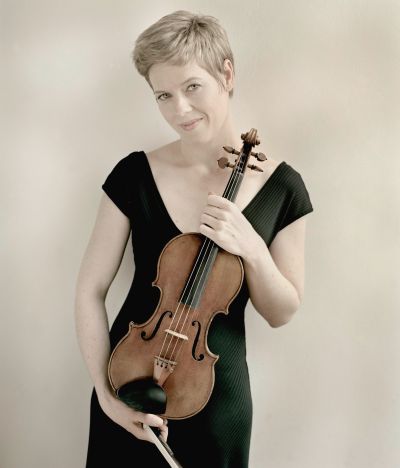 United Kingdom Beethoven, Bartok, Brahms: Isabelle Faust (violin), Alexander Melnikov (piano), Wigmore Hall, London, 13.5.2013 (GD)Beethoven: Violin Sonata No. 3 in E flat, Op 12 No.3
United Kingdom Beethoven, Bartok, Brahms: Isabelle Faust (violin), Alexander Melnikov (piano), Wigmore Hall, London, 13.5.2013 (GD)Beethoven: Violin Sonata No. 3 in E flat, Op 12 No.3
Bartok: Violin Sonata No.2
Brahms: Violin Sonata No. 1 in G, Op 78
- Isabelle Faust: Photo: Felix Broede
Faust and Melnikov have achieved the highest praise worldwide for their extraordinary musicianship and spell-binding rapport when they play together. One has only to listen to their complete recordings of the Beethoven sonatas, or their individual solo recordings of Bach and Shostakovich to hear this confirmed. After the Haydnesque inflections, bold transitions and youthful experiments in counterpoint heard in the opening early Beethoven sonata it was something of a revelation to be plunged into the elemental world of Bartok’s Second ViolinSonata, with its ‘hora lunga’ – a kind of long drawn out Romanian peasant melody which Bartok discovered in Transylvania. Here it sounded like a rough ground bass, improvised, having no fixed tonal register. Bartok’s writing here (the instrumental placing) does not register easily with the more classical sense of instrumental harmony and dialogue. But here Faust, with her up-down scale melody and Melnikov’s full use of mirror matching motion of the two hands, thus accumulating harmonic tension, had about them an almost perfect sense of synergy.
I say ‘almost’ because I don’t think Bartok was aiming for the classical paradigm of perfect symmetry. This sense of mismatched synergy, in the music and inevitably in the playing, actually mirrors the relationship between the sonata’s two movements. The ‘hora lunga’, mentioned in the work’s opening, is recast so to speak in microsomic form in the second movement – something used increasingly in Bartok’s later music. Here Bartok inflects the ‘hora lunga’ theme with typically, highly rhythmic folk song stanzas. A semblance of the ‘hora lunga’ with its folksy improvisatory tone is also heard (more hauntingly) in the sotto voce C major coda of the work. Throughout this quite daunting work both Faust and Melnikov seemed to be in their element, Melinikov making some furious pianistic attacks especially in the opening and in the furious folk rhythms in the second movement. and Faust’s up-and down scale runs projecting an amazing tonal frisson, seeming to fill the whole hall. Faust and Melnikov had originally programmed Bartok’s First Violin Sonata but changed this to the Second Sonata.
As with the Bartok Faust and Melnikov changed the original programme choice of the Brahms Violin Sonata No. 2 in A, Op.100, to the Violin Sonata No. 1 in G major Op. 78. In this most lyrical of Brahms’ works the opening motif for violin has a song-like,almost dance-like, grace from its first three bars. And indeed, Brahms takes this initial melody from one of his Op. 59 songs. Throughout this glowingly lyrical movement the piano avoids any added contrapuntal lines, giving added freedom to the violin. Not since the classic recording with Gioconda de Vito and Edwin Fischer have I heard such delicacy and freedom of phrasing in the violin part, made all the more eloquent by Faust’s decision to deploy the absolute minimum of vibrato. Both Faust and Melnikov imbued the second movement’s E flat melody – a song to Clara Schumann – with all the restrained passion one could wish for. The central funeral march in B minor, making prominent use of the first movement’s dotted rhythm – part of Brahms’s quest for thematic unity – had all the necessary sense of solemnity and gravitas often heard in Brahms’s music. All the novelties of the finale – the key of G minor, the use again of the Op 59 songs, the final reestablishment of G major, the interweaving of fragments of the second movement with the coda – were all beautifully contoured and incorporated with a total unanimity and harmony between Faust and Melnikov.
As an encore to this truly memorable recital we were given some rarely heard Weber.: the second movement from his Op 10 No. 3 Violin Sonata, a kind of tarantella-like short scherzo. Predictably played with all the agility and humour this music demands. Faust and Melnikov have just recorded the complete set of the Op 10 Sonatas, together with Weber’s rarely heard Piano Quartet.
Geoff Diggines.
